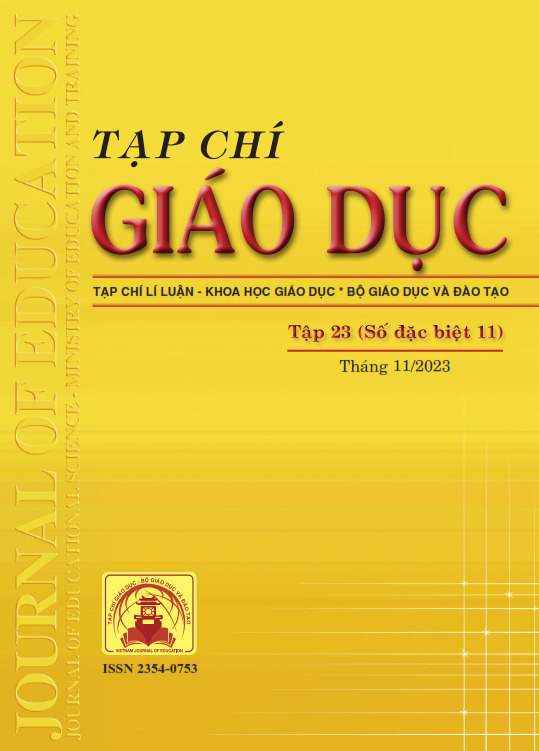Dạy học lập trình Python nội dung “Câu lệnh rẽ nhánh” (Tin học 10) theo chu trình 5E
Tóm tắt
The conditional branches are a pivotal concept present in every programming language. This fundamental knowledge is a requirement for anyone studying programming. In instructional methodologies, the 5E model encourages intrinsic motivation, urging learners to construct their knowledge independently. The learner's desire for exploration and discovery results in a deeper and more intrinsic understanding compared to traditional teaching methods. However, currently, there is no literature in our country discussing the teaching of conditional branches using the 5E instructional model. Therefore, this is the gap that the article aims to focus on. In this paper, we present perspectives on teaching through the 5E instructional model, the control structure of conditional branches in Python, the process of teaching Python programming focusing on the conditional branches’ structure using the 5E model, as well as organizing the teaching of Python programming with a focus on the conditional branches using the 5E model in the context of BMI measurement problems at 10th grade.
Tài liệu tham khảo
Atkin, J. M., & Karplus, R. (1962). Discovery or invention?. The science teacher, 29(5), 45-51.
Bybee, R., & Landes, N. M. (1990). Science for life and living: An elementary school science program from Biological Sciences Improvement Study (BSCS). The American Biology Teacher, 52(2), 92-98.
Cakir, N. K. (2017). Effect of 5E learning model on academic achievement, attitude and science process skills: meta-analysis study. Journal of Education and Training Studies, 5(11), 157-170.
Dương Giáng Thiên Hương (2017). Dạy học khám phá theo mô hình 5E - Một hướng vận dụng lí thuyết kiến tạo trong dạy học ở tiểu học. Tạp chí Khoa học, Trường Đại học Sư phạm Hà Nội, 62(4), 112-121.
Duran, L. B., & Duran, E. (2004). The 5E Instructional Model: A Learning Cycle Approach for Inquiry-Based Science Teaching. The Science Education Review, 3(2), 49-58.
Hồ Sĩ Đàm, Hồ Cẩm Hà, Đỗ Đức Đông, Nguyễn Đình Hóa, Lê Minh Hoàng, Nguyễn Thế Lộc, Nguyễn Chí Trung, Nguyễn Thanh Tùng (2023). Tin học 10. NXB Đại học Sư phạm.
Nguyễn Đăng Thuấn, Nguyễn Hoàng Phúc (2020). Vận dụng “Mô hình dạy học 5E” trong dạy học chương “Chất khí” (Vật lí 10) ở trường trung học phổ thông. Tạp chí Giáo dục, 492, 34-39.
Nguyễn Ngọc Giang, Trương Quang Duy Thịnh, Dương Hoàng Bích Thuận, Nguyễn Viết Dương, Phạm Thị Hồng Hạnh. (2020). Chuyên đề bồi dưỡng toán thực tế lớp 9. NXB Đại học Quốc gia Hà Nội.
Nguyễn Thành Hải (2014). Mô hình dạy học 5E trong giáo dục STEM. https://hocvienkhampha.edu.vn/mo-hinh-day-hoc-5e-trong-giao-duc-stem/
Ong, E. T., Govindasamy, D., Singh, C. K. S., Ibrahim, M. N., Wahab, N. A., Borhan, M. T., & Tho, S. W. (2021). The 5E inquiry learning model: Its effect on the learning of electricity among Malaysian students. Cakrawala Pendidikan, 40(1), 170-182.
Patel, D. A. (2019). Effects of 5E learning Cycle Model on Achievement in Social Science of Std-8. International Journal of Trend in Scientific Research and Development, 3(3), 1836-1837. https://doi.org/10.31142/ijtsrd21726
Phạm Thế Long, Đào Kiến Quốc, Bùi Việt Hà, Lê Chí Ngọc, Lê Kim Thư (2023). Tin học 10. NXB Giáo dục Việt Nam.
Tezer, M., & Cumhur, M. (2017). Mathematics through the 5E Instructional Model and Mathematical Modelling: The Geometrical Objects. Eurasia Journal of Mathematics Science and Technology Education, 13(8), 4789-4804.
Turan, S., & Matteson, S. M. (2021). Middle School Mathematics Classrooms Practice Based on 5E Instructional Model. International Journal of Education in Mathematics, Science and Technology, 9(1), 22-39.
Đã Xuất bản
Cách trích dẫn
Số
Chuyên mục
Giấy phép

Tác phẩm này được cấp phép theo Ghi nhận tác giả của Creative Commons Giấy phép quốc tế 4.0 .












